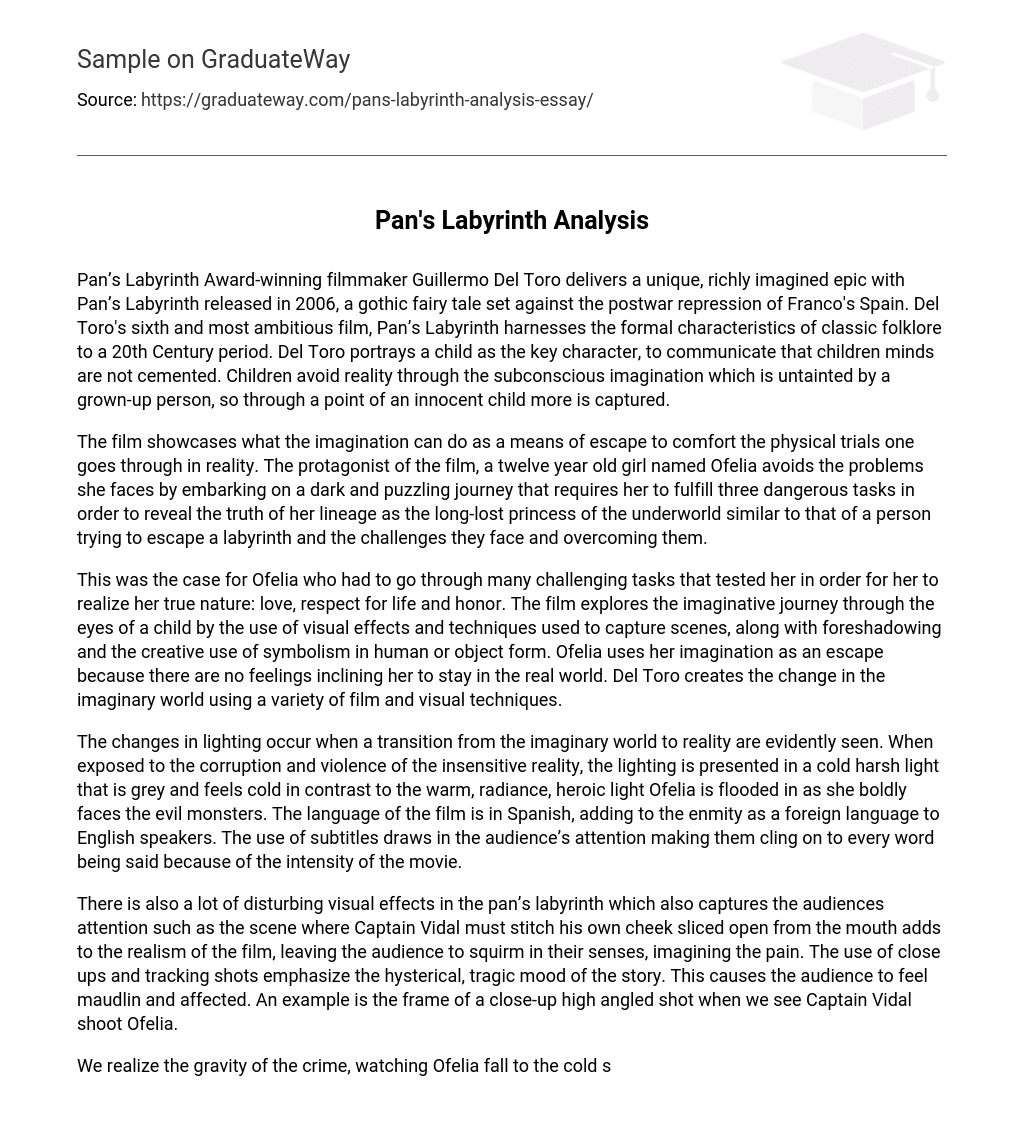Guillermo Del Toro, an award-winning filmmaker, created a unique and vivid epic called Pan’s Labyrinth in 2006. This gothic fairy tale is set against the backdrop of Franco’s Spain after the war. Del Toro’s sixth and most ambitious film combines the classic characteristics of folklore with a 20th Century setting. The film centers around a child as the main character, highlighting the idea that children have flexible minds. They escape reality by using their untainted subconscious imagination, unlike adults. By using an innocent child’s perspective, Del Toro is able to capture more in his storytelling.
The film highlights the power of imagination to provide solace from the hardships of reality. Ofelia, a 12-year-old girl and the film’s protagonist, uses her imagination to navigate a mysterious and difficult journey that involves completing three perilous tasks. This journey serves as a metaphor for escaping a labyrinth-like situation and overcoming challenges. Ultimately, it allows Ofelia to uncover the truth about her heritage as the long-lost princess of the underworld.
Ofelia, a character in the film, undergoes numerous difficult tasks that serve as tests to help her discover her true nature – love, respect for life, and honor. The movie employs visual effects, scene capture techniques, foreshadowing, and symbolism in both human and object form to portray the imaginative journey from the perspective of a child. Due to a lack of emotional attachment to the real world, Ofelia relies on her imagination as a means of escape. Del Toro effectively introduces changes within the imaginary realm through the application of various film and visual techniques.
The lighting changes reflect the transition from the imaginary world to reality. When confronted with the corruption and violence of an insensitive reality, the lighting takes on a cold, harsh grey tone, in contrast to the warm and radiant heroic light that surrounds Ofelia as she bravely confronts the evil monsters. The film’s language is in Spanish, adding to the sense of foreignness for English-speaking viewers. The use of subtitles grabs the audience’s attention, compelling them to hang on every word due to the movie’s intensity.
In addition to captivating the audience, Pan’s Labyrinth also includes numerous unsettling visual effects. These effects contribute to the film’s realism and evoke sensations of discomfort among viewers. For instance, there is a scene where Captain Vidal is forced to sew up a deep cut on his cheek, emanating a sense of pain that resonates with the audience. Moreover, the film’s use of close-ups and tracking shots intensifies the story’s distressing and tragic atmosphere. Consequently, viewers are inclined to experience melancholic emotions and become emotionally affected. One illustrative instance is when Captain Vidal shoots Ofelia, portrayed through a close-up high angled shot.
We understand the seriousness of the crime, witnessing Ofelia’s descent onto the chilly stone floor as her blood trickles towards the entrance of the Underworld realm. Del Toro also employs foreshadowing as a technique in portraying a predestined outcome for the protagonist and hinting at what awaits her in later parts of the film. In a particular scene, when her mother is lying on the bed and the baby begins to kick, she instructs Ofelia to tell a tale to her unborn brother to soothe him. Ofelia’s story revolves around suffering, grief, and the reward of eternal life in the end.
The fable she narrates predicts the creativity she possesses for the challenges she encounters in real life and her response to it. Del Toro’s movie portrays the voyage of personal choice and the connection between destinies and the decisions we make to conquer the hurdles we confront. Del Toro developed his film with a contrasting viewpoint compared to conventional movies. In Pan’s Labyrinth, every element transforms into a representation, from the actors to the backdrop. Del Toro is a knowledgeable creator for whom the visuals and symbols of bygone eras serve as diverse fragments of a hidden and mystical reality.
According to him, directing a film means combining disparate fragments into a cohesive narrative. Thus, in Pan’s Labyrinth, a damaged watch can communicate with the audience just as effectively as the acting. Del Toro’s direction turns statues into actors and actors into statues because the visual details and the messages they convey evoke powerful emotions. Instead of simply applying cinematic techniques, Del Toro’s approach to mise en scene involves using symbols and icons in his storytelling process.
An example of that would be the classic symbols of fairy stories being utilized to represent the imaginary world in which Ofelia travels. The labyrinth symbolizes the choices she must make in her journey and the obstacles she encounters. The cast of mythical characters, such as fauns and fairies, and giant toads that dwell beneath fig trees in the mystical forest, are located deep within. Similar to a writer, Del Toro selects symbols based on their meaning and beauty, combining them to create a visually appealing cinematic syntax.
The enigmatic fairy tale captivates us with its uncertainty, leaving us pondering whether the protagonist’s struggle to establish her identity as the lost princess of the underworld realm was a battle against the symbolic representations of conscious morality or an escape from the cruel lack of empathy prevalent in reality. The unanswered queries posed by the narrative serve the director’s purpose of encouraging us to hold onto our individual beliefs and utilize our own imaginations to draw conclusions, regardless of their nature. This introspection challenges our perception of reality and prompts us to question the existence of magical possibilities or rely solely on logic.





